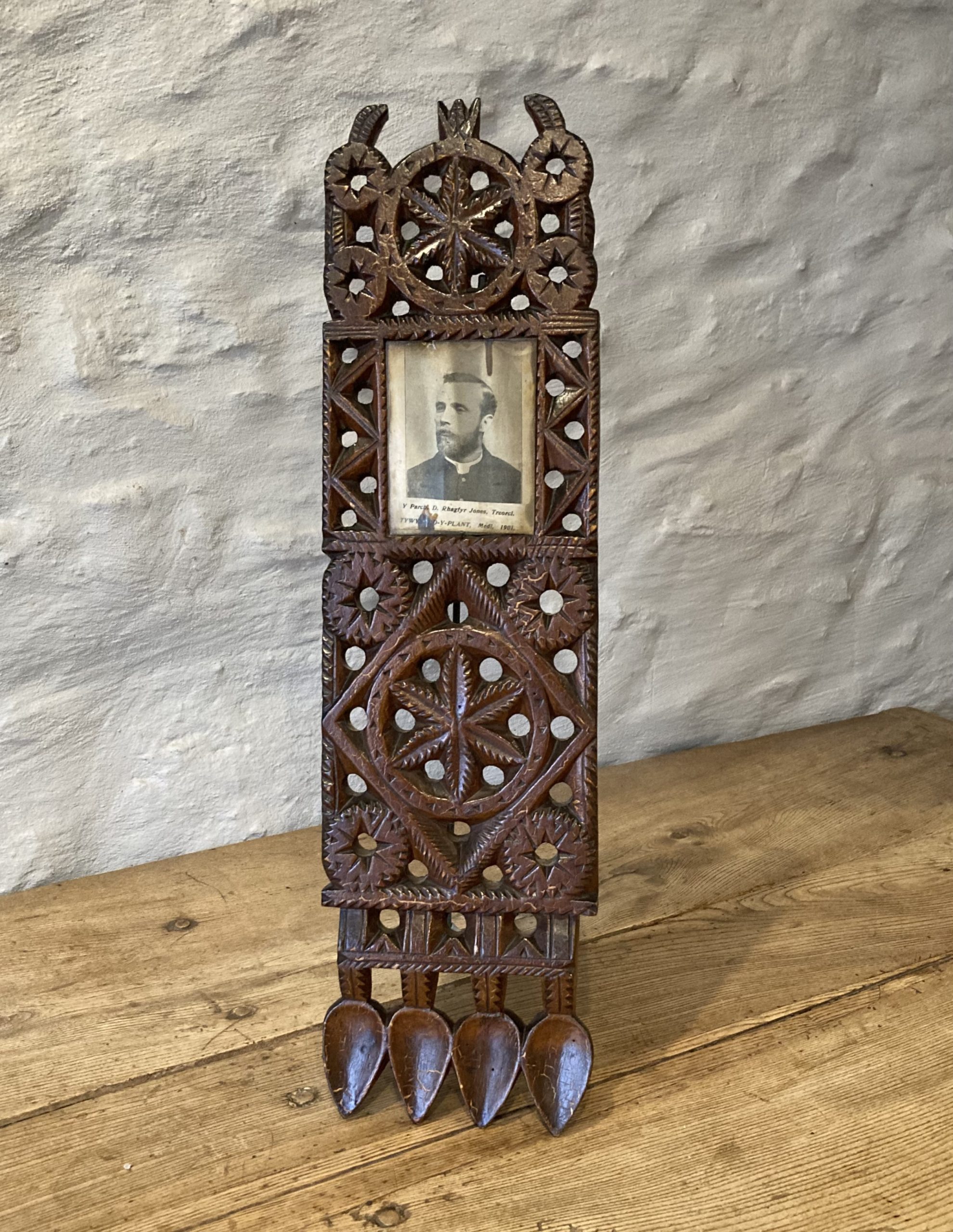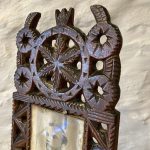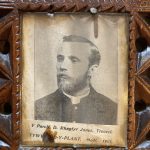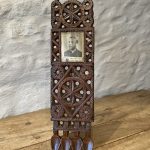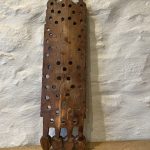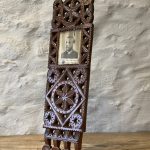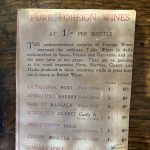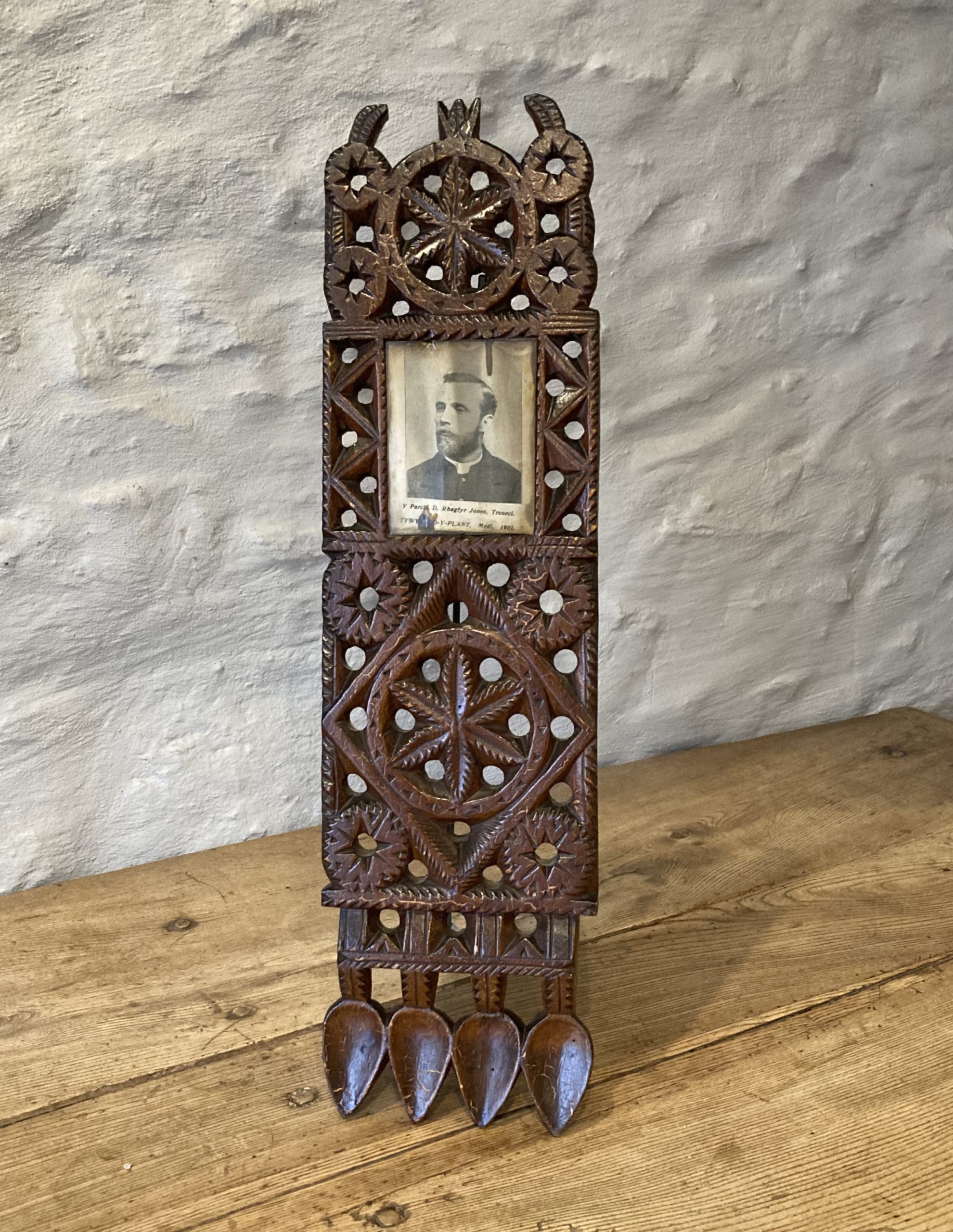A large Welsh lovespoon, unusually carved with four bowls and elaborate pierced and carved decoration, made from a single piece of sycamore with the original shellac varnish finish.
22” high x 6 ½ wide x ¾” deep / 55.8cm high x 16.5cm wide x 1.9cm deep
South Wales circa 1900
£2850 Sold
It has a glazed recessed panel which holds a photograph of
‘Y Parch D. Rhagfyr Jones, Treorci, Tywysydd y Plant, Medi 1901.
The Rev D.Rhagfyr Jones, Treorchy, The Children’s Guide, September 1901.
(Tywysydd y Plant was a monthly Welsh language religious periodical intended for Sunday schools)
19th century lovespoons with glazed panels are known but it is very unusual to find a spoon that holds a picture of a Welsh minister. It is generally thought that lovespoons were crafted by male suitors and then presented as romantic gifts to the girl that they were attracted to. Because there is very little actual evidence about the custom of the making, giving or receiving of lovespoons, could this spoon perhaps offer an alternative idea and suggests that they were also owned or given as a symbol of affection or admiration and not necessarily as a token of romantic love, or perhaps both?
The image of a Welsh minister in a lovespoon is very unusual and it gives us an insight into the high esteem that these ministers were held.
During the 19th and early 20th centuries, widespread and popular revivals of nonconformist Christian religion swept across the whole of Wales.
During this period, the vast majority of the Welsh population attended chapel on a regular basis. Chapels were built in almost every town and village to serve the religious needs of the various denominations known as the Baptists, Unitarians, Congregationalists, Methodists and Presbyterians. The Ministers became household names and attracted a huge following, comparable to influencers or pop stars today, often preaching to crowds of hundreds at a time. Powerful religious awakening soon spread throughout Wales and the last of these revivals took place in 1904 headed by the most famous – Evan Roberts. Roberts, often photographed surrounded by loyal followers, usually female, travelled with his reporter from the Western Mail such was his fame and the clamour for news about him and the revival.
Below is a translation of a notice for D. Rhagfyr Jones from Y Blwyddiadur Undeb yr Annibynnwyr Cymraeg, 1916 (The Union of Welsh Independents’ Yearbook 1916)
D. RHAGFYR JONES, TREORCI
He was born in Dolgellau where he was raised in a family well-known for their religiousness, He received his academic education in Bala. He was ordained in Cefncoedycymer, 13 April 1881. Then he worked as a minister in Pontargothi, 1887–96, and Bethania, Treorci, from 1896 until 3 April 1915, when he died quietly at 57 years of age, and escaped the many and terrible tribulations that beset him. Bethania church has been particularly kind towards him and his family during his long illness, and so too his brothers in the ministry. Our brother possessed a steadfast personality and a strong and complex mental acumen. He was a wonderful poet, musician, and author, as well as being an excellent preacher, who was noted for the thoughtfulness, newness and richness of his message. His delivery was both sharp and profound, and could at times have great influence. It is without any dispute that the vigour he threw into his contemplations and into the tradition took a heavy toll on his strength. His burial is testimony to the great respect in which he was held.
A report of the funeral of Revd D Rhagfyr Jones in the Welsh Independents’ weekly newspaper Y Tyst is held in the National Library of Wales and a link & précis are below:
https://newspapers.library.wales/view/3800427/3800433
Burial of Revd D. Rhagfyr Jones, Treorci
(A précis of the long report in the Welsh Independents’ weekly newspaper Y Tyst, 14 April 1915 – translated by Elinor Wyn Reynolds)
After a long and gruelling illness, the Revd D. Rhagfyr Jones took a turn for the worse on Good Friday, rising to glory on Easter Saturday. It was seen as coincidence that he had been established as the minister at Bethania, Treorci nineteen years previously on Good Friday. The Tyst report of his funeral notes that the magnitude of the event reflected the respect and esteem in which he was held by his fellow ministers and also by his congregation.
It was his dying wish that the funeral should be officiated by the Revd J. J. Williams, Morriston (J. J. Williams was minister at Tabernacl, Treforys, one of the largest Independent churches in Wales, he was a poet and subsequently became Archdruid of Wales). A short service was held at the house by J. J. Williams aided by local ministers Revd T. E. Jones (Efailisaf) and Revd T. jones (Ferndale). A hymn was sung before leaving the house and another hymn was sung during the journey to the chapel.
The chapel was full with mourners who all stood in respect as the coffin arrived and was carried to the front whilst the organ played the ‘Dead March’. Many eulogies were given by numerous ministers as well as readings and prayers. It was also revealed that D. Rhagfyr Jones had posthumously won first prize for a writing the words and music for a hymn in a local competition. His hymntune was named ‘Tynybedw’.
The orations during the funeral were fulsome, eloquent and ecstatic in parts, reflecting not only Rhagfyr Jones’ status in the community, but also the way that ministers at such gatherings would ineviytably be carried on the wave of emotion and religious zeal. His character and abilities were praised highly by the speakers; indeed he was known as a musician, lecturer, preacher and author of repute. He was also known as a man who had suffered during his lifetime (due to illness) and had borne it well.
The funeral procession then left the chapel and walked to the cemetery for the burial, this time with the choir accompanying the procession by singing a hymn.
A list of the mourners is given, as well as a comprehensive list of all ministers present, over 40 in total, as well as other local dignitaries. It is noted that letters of condolence were also sent by fellow ministers, local members of parliament and other friends.
A funeral tea was held following the burial for all present.
(This report is almost hyperbolic in the strength of emotion and feeling, but it accurately reflects the mores of the time.)
Many people who were involved in nonconformist religion were active in the temperance movement and promoting the alcohol-free way of life. But interestingly that behind the photo of D. Rhagfyr Jones is a printed piece of paper showing a price list for various ‘Pure Foreign Wines’ from W & A Gilbey wine & spirit merchants.
A similar spoon is illustrated in ‘Traditional Spoon carving in Wales’ by Gwyndaf Breese, Gwasg Carreg Gwalch 2006
And similar spoons can be seen in Carmarthen country museum, in Abergwili, Carmarthenshire.



